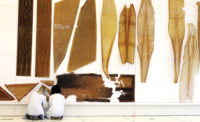Bodys Isek Kingelez's 'Art inSight' at MoMA

Ville Fantôme (1996)
Photo © Maurice Aeschimann, courtesy CAAC-The Pigozzi Collection

Kinshasa la Belle (1991)
Photo © Maurice Aeschimann, courtesy CAAC-The Pigozzi Collection

Stars Palme Bouygues (1989)
Photo © Vincent Everarts Photography, courtesy Van Lierde Collection

Sports Internationaux (1997)
Photo © Queensland Art Gallery / Gallery of Modern Art Foundation, Natasha Harth




The Democratic Republic of Congo (DRC) has a long history of larger-than-life characters—politicians, musicians, and even the man or woman on the street—who display a grandiose sense of self that often confounds outsiders. Bodys Isek Kingelez (1948–2015), whose work is currently on view in all its astonishing glory at New York’s Museum of Modern Art (MoMA), was such a Congolese archetype. Throughout his career, the artist promoted myths about his renown and abilities, declaring himself “a small god.” In his visionary art, he created fantastical miniature buildings and cities—and once told a curator that “all great American architects had plundered all his ideas.”
We can forgive him his hubris. Though he first came into prominence in Europe as part of a group exhibition, Magiciens de la terre, in Paris, in 1989, the MoMA show, expertly curated by Sarah Suzuki, is his first retrospective in the U.S., and it is a revelation. Titled Bodys Isek Kingelez: City Dreams, it features 33 small structures and models of cities that could be categorized as both sculpture and make believe architectural maquettes. In his early work, Kingelez used found packaging, cardboard, and other materials that he glued together and assembled into playful but not yet elaborate miniature buildings. The later work, such as his intricately detailed masterpiece Ville Fantôme (1996), is testimony to his improved economic status as he became known, accepted commissions from European collectors, and could employ finer materials (though he still occasionally used objects like soda and beer cans in a work such as Sports International). Consistent through various periods of his career is the extraordinarily detailed ornamental painting, the vibrant colors, the lively calligraphy, and the ambition of each piece. Some of his work shows influences of Art Deco and the emerging postcolonial architecture that began to appear in Kinshasa and other parts of the DRC during the era of dictator Mobutu Sese Seko (1965–97), designed by architects like the Tunisian Olivier Clement Cacoub and the Congolese Fernando Tala-Ngai. Most of Kingelez’s pieces, however, are the artist’s own reimagining of what a building might become, defying traditional ideas of form and function in ways that would perplex any structural engineer.
Born in a small Congolese village, Kingelez moved to the capital, Leopoldville (now Kinshasa), in 1970 to study at the local university in subjects ranging from business to industrial design. In the mythology, after a stint teaching (and he was, by his own telling, “an excellent teacher”), he was struck by a feverish desire to work with his hands. His sculpture Musée National was so striking that a neighbor encouraged him to show it. At the national museum of the Congo, disbelieving staffers challenged him to make another piece as they watched, in order to authenticate his prowess. Inspired by Mobutu’s promotion of the arts and the push to develop a modern Congolese style, Kingelez developed his unique work. His dreamy and vibrant worlds grew from an obsessive interest in cities at a time when urban centers in Africa had not begun to swell into the megalopolises they are today. Kinshasa’s population has multiplied many times over, to 12 million people, since Kingelez first arrived there as a student.
For Ville Fantôme, the centerpiece of the MoMA show, he created over 40 single buildings, each carefully detailed, along with roads, parks, and public spaces. The designs are a surprising mix of familiar architectural motifs with fantastical forms crafted from translucent sheeting, plastic, cardboard, and various paper stock, all meticulously painted. Kingelez knew he was creating a utopia: in his writings, he described Fantôme as having “no police force . . . to protect the city, there are no soldiers to defend it, no doctors to heal the sick. It’s a peaceful city where everybody is free. It’s a city that breathes nothing but joy, the beauty of life. It’s a melting pot of all races in the world. Here you live in a paradise, just like heaven.” His projects are a paradise of public buildings, convention centers, and sports arenas, but, in a fascinating omission, there are no cars or people—a reminder that, rather than look at Kingelez’s work as real architectural propositions, they should be viewed as art. Fantôme, like his other sculptures, is conceived as a secular vision of an elusive and prosperous future from the mind of a self-assured nonconformist. “Kingelez is not an architect and does not wish to be considered one,” a friend, quoted in the exhibition catalogue, once said. “He is surprised when you ask him if he wants to see his works actually built.”
Still, his art dares anyone engaged in creating the built environment today—architects, artists, planners, builders—to dream bigger and bring a sense of wonder into imagining the future.






